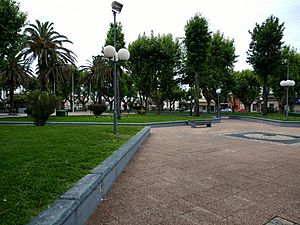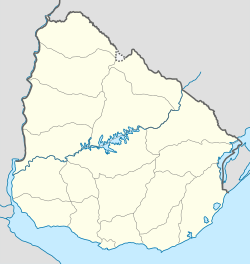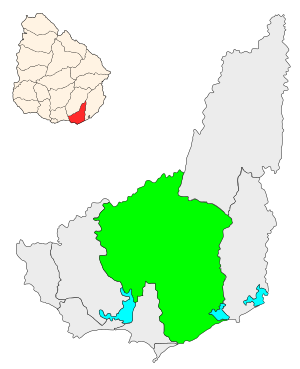San Carlos, Uruguay facts for kids
Quick facts for kids
San Carlos
|
||
|---|---|---|
|
City & Municipality.
|
||

Plaza Artigas
|
||
|
||
| Country | ||
| Department | ||
| Founded | 1763 | |
| Elevation | 24 m (79 ft) | |
| Population
(2011 Census)
|
||
| • Total | 27,471 | |
| • Demonym | carolino | |
| Time zone | UTC -3 | |
| Postal code |
20400
|
|
| Dial plan | +598 42 (+6 digits) | |
| Climate | Cfa | |
San Carlos is a city in the southern part of Uruguay, located in the Maldonado Department. The name "San Carlos" also refers to the larger area, or municipality, that the city is a part of. This municipality includes the city itself and many other smaller areas and towns.
Contents
Exploring San Carlos's Location
The city of San Carlos is found along Route 39. It is about 2 kilometers (1.2 miles) south of where Route 39 meets Route 9. San Carlos is also about 13.5 kilometers (8.4 miles) north of Maldonado, which is the main city of the department. The Arroyo San Carlos stream flows along the eastern edge of the city. On the other side of this stream is a park and neighborhood called Parque Medina.
A Look Back at San Carlos's History
San Carlos was started in October 1763. It was founded by the Spanish Governor Pedro Antonio de Cevallos. His goal was to stop the Portuguese from setting up their own towns in the area. The city was named after the King of Spain at that time, King Charles III.
Before Uruguay became an independent country, San Carlos was known as a "Villa" (a town). Later, on December 18, 1929, it was officially made a "Ciudad" (a city) by a special law (Ley Nº 8.559).
San Carlos's Population Today
In 2011, the city of San Carlos had a population of 27,471 people. This makes it the second-largest city in the Maldonado Department. The capital city, Maldonado, is the largest. The local government of Maldonado Department says that the entire San Carlos municipality has about 27,000 residents.
Population Growth Over Time
Here's how the population of San Carlos has grown over the years:
| Year | Population |
|---|---|
| 1908 | 5,014 |
| 1963 | 13,695 |
| 1975 | 16,925 |
| 1985 | 19,877 |
| 1996 | 24,030 |
| 2004 | 24,771 |
| 2011 | 27,471 |
Source: Instituto Nacional de Estadística de Uruguay (Uruguay's National Institute of Statistics)
Economy and Local Activities
San Carlos is known as the main center for farming and ranching in its region. This means that agriculture, like growing crops and raising animals, is a very important part of its economy.
Places to Worship in San Carlos
The city has several places where people can go to worship:
- Parish Church of St. Charles Borromeo (a Roman Catholic church)
- Parish Church of St. Pius X (another Roman Catholic church)
- San Carlos Ward LDS (a church for members of The Church of Jesus Christ of Latter-day Saints)
Famous People from San Carlos
Many notable people have come from San Carlos, including:
- Luis Barrios Tassano, a lawyer and politician.
- Manuel Basilio Bustamante, who was an interim President.
- Cayetano Alberto Silva, a talented musician.
- Mariano Soler, the first Archbishop of Montevideo.
- Francisco Antonino Vidal, who served as President.
- Marta Albertini, an actress.
- Leonardo Olivera, a military officer.
- Matías Britos, a professional footballer.
- Darío Pérez Brito, a doctor and politician.
- Óscar de los Santos, a politician.
- Ruperto Elichiribehety, a navy officer.
See also
 In Spanish: San Carlos (Uruguay) para niños
In Spanish: San Carlos (Uruguay) para niños




